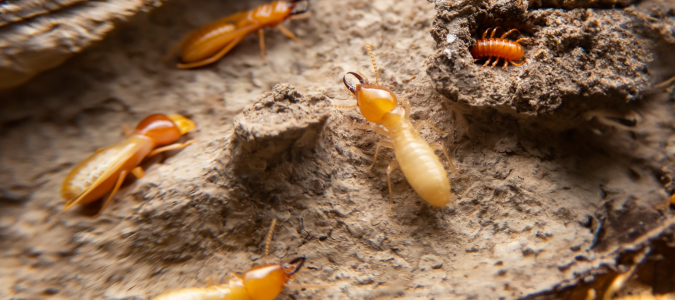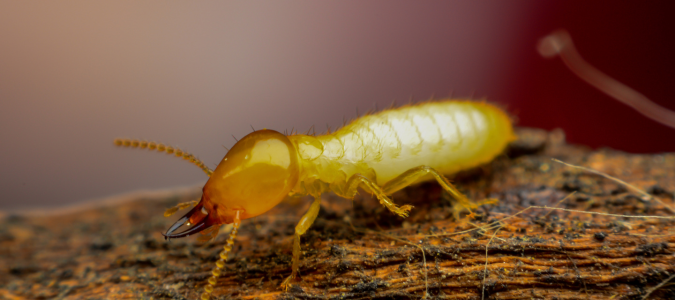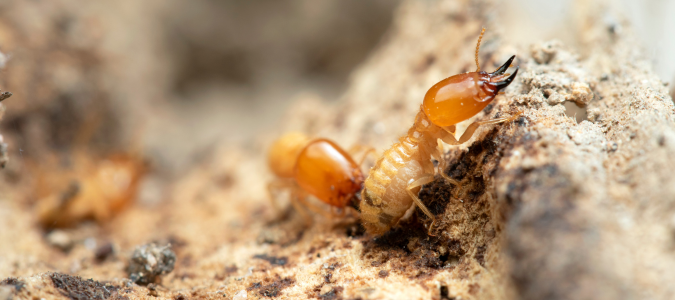Have you ever seen a termite? These pests are hard to spot, especially since they spend most of their lives staying out of sight from humans. However, it’s still important for homeowners to learn about the appearance of termites, such as how small they are and what termites look like.
If you suspect a termite infestation in your home, contact a pest control company.
How Small Are Termites?
How small are termites? There are several species of termites, like subterranean and drywood termites, but they are all small pests. In fact, termites only range in size from one-eighth to three-eighths of an inch long. The tiniest termites are around the size of a grain of rice while larger termites are near the size of a paper clip.
While understanding the size of termites is helpful, it’s important for homeowners to know other aspects of termites’ appearance. The more you know, the easier it will be to identify termites in your home or on your property.
It’s also crucial to remember that termites can cause structural damage to your home that is costly and time-consuming to repair. The earlier you can catch an infestation, the better off you’ll be.
Termites have long, oval-shaped bodies that range in color depending on their place in the colony. For example, worker termites are light-colored and can look almost translucent while swarmer termites are darker in color.
Termite Castes
Several other physical differences are also determined by the termite castes. Worker termites do not have wings, as they never leave the nest. Their job is to forage for food, construct the termite nest and care for the young. These subterranean termites have no use for vision and do not develop eyes.
Next, soldier termites are similar in color to worker termites, but they have bigger heads that have strong mandibles protruding from them. Their job is to protect the colony from outside threats, so they use their mandibles for defense.
The soldier termites’ larger heads also serve a purpose; if they sense a threat, they bang their heads against the wall of the termite nest to create a vibration that sends a message to the rest of the colony.
Finally, swarmer termites have the most physical differences from the other castes. The swarmers, also known as reproductives or alates, leave the nest to mate and establish new nests. They are the only termites with wings, as they mate after flying out of the nest. Their “mating flight” creates a swarm of termites in one area, which is why they’re called swarmers.
After their mating flight, both male and female swarmer termites shed their wings and begin new colonies. Male termites do not die after mating, unlike other pests, such as ants. Instead, male and female termite pairs establish a new colony together and continue to reproduce.
Signs of a Termite Infestation
Understanding the appearance of termites is important; however, these pests are extremely skilled at staying out of sight. They are also tiny and hard to see, especially since some look translucent.
It’s more likely that you’ll notice the signs of termites around your home before you see any of these pests. For this reason, it’s vital that homeowners are well aware of these signs, as well as when termite season is.
An obvious sign of termites is the presence of mud tubes around your property. Termites build mud tubes to use as tunnels to travel between their nests and food sources. You may spot them on your walls, around your home’s foundation or other surfaces.
In size and shape, mud tubes look like pencils. However, they can vary in color depending on their age. Newer mud tubes are darker and look moist, while older mud tubes are lighter and look dry.
Next, a common sign of a termite infestation is seeing discarded wings around your home. Reproductive termites discard their wings after their mating flight, so it’s common to see multiple pairs in one area. You may spot these translucent wings around your windows, doors or other entry points to your home.
Termites are known for causing significant wood damage, which you may notice before you actually see a termite. You can tell if termites are inside your wood by knocking on it and listening for a hollow sound. Since these pests chew wood from the inside out, your wood may start to buckle or splinter as the damage increases. Paint on the wood could also start to bubble.
Finally, termite damage can warp your doors and windows, making them harder to open and close. If you notice your doors or windows are sticking, it could be due to termites taking up residence inside of them.
If you notice any of these signs of termites around your home, contact a pest control service. Even if you aren’t completely sure if termites are present, it’s better to be proactive and get ahead of costly termite damage.
Do Termites Bite People?
It’s extremely rare for termites to bite people, but it can happen. However, it only happens when termites feel threatened by humans, and the only termites that bite are the soldier termites. These termites have strong mandibles, or jaws, that protrude from their heads. They use them to attack other small insects that are threatening their colony.
Termite bites are typically harmless to humans. These pests do not seek out humans or pets to bite and only bite to defend themselves.
Instead, termites actively cause damage in other ways. For example, they can cause severe structural damage to your home. Termites feed on wood from the inside out, and they can often do significant damage before they are even noticed.
Termite damage can include wood beams, hardwood floors, wood furniture and more. Along with wood, they also feed on other cellulose-based materials, including textiles, paper products and insulation.
By the time you start to notice termite damage, it may already be severe. This is why homeowners should keep an eye out for the signs of termites. If you notice those signs, contact a pest control service. Termite infestations require professional treatments to control, and the sooner you act, the more damage you will avoid.
Do Termites Go Away On Their Own?
Termites are persistent pests that do not go away on their own. On the contrary, termites can cause significant structural damage to your home when left untreated.
As long as termites have access to food and shelter, they will remain where they are. Your home acts as the food that termites need to survive, so they will not leave it on their own. Unchecked termite colonies can grow into the thousands, and termites work around the clock. It’s extremely important that you don’t ignore an infestation.
It’s important to deal with a termite infestation quickly to avoid costly damage.
If termites are taking up residence in your home, contact a local pest control company. The experts will have the tools and experience required to deal with termite infestations of all sizes and severities.
Kick Out Termites With Expert Help
Termites may be tiny, but they can cause big problems. These pests are persistent and require expert intervention to control. Homeowners must stay vigilant to the signs of a termite infestation and act quickly if they suspect that these pests are doing damage to their home.
Remember that termites will not go away on their own, and the sooner you act, the less damage can be done.
ABC Can Help With Pest Infestations of Any Kind
Finding termites in and around your property can be extremely concerning. These pests are destructive and their colonies can hold thousands of members. If you suspect termites on your property, contact ABC Home & Commercial Services. Our professionals will be able to locate the termite colony and then implement an effective termite control plan.



